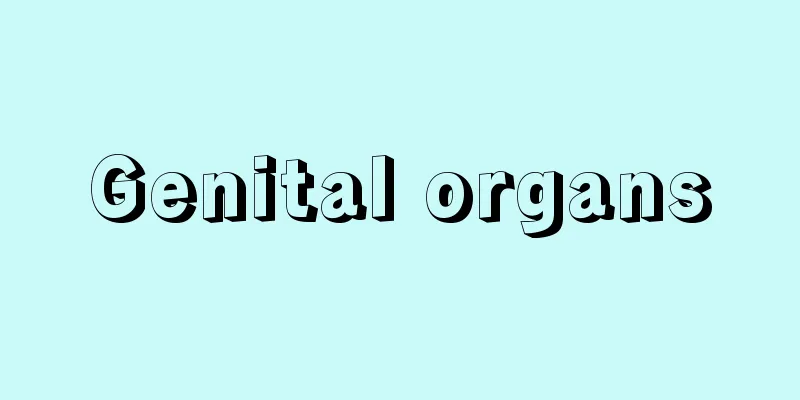Genital organs

|
The genitals are the organs responsible for the reproduction of offspring in humans and other living organisms, and are also called reproductive organs or sex organs. This article on genitals will focus on the morphological and functional explanations of humans, and will leave the involvement of hormones in animals and plants to the article on "reproductive organs." The structure of the genitals differs significantly between men and women. Essentially, they consist of gonads that produce the reproductive elements sperm and eggs (gametes), reproductive ducts that transport gametes, and accessory gonads and copulatory organs that facilitate transport. Developmentally, human genitals are differentiated into external genitalia and internal genitalia. The external genitalia are the genitals that are visible on the outside (the so-called vulva) and are primarily used as copulatory organs. The internal genitalia are the organs responsible for reproductive functions. [Kazuyo Shimai] Male genitalia
[Kazuyo Shimai] Testis, epididymis, and vas deferensThe testes are a pair of organs that reside inside the scrotum. They are slightly flattened ellipsoids, measuring approximately 5 cm along the long axis, 3 cm wide, and 2 cm thick, and weigh 8 to 8.5 grams. The long axis of the testes is tilted from the front at the top to the back at the bottom. In general, the left testis is slightly lower than the right testis. The testes are surrounded by a tunica albuginea, which is made of tough fibrous connective tissue. The tunica albuginea at the rear edge of the testes thickens to form a mass called the mediastinum testis (mediastinum testis), from which a thin sheet of connective tissue invades the interior of the testes, dividing them into 200-300 testicular lobules. Each lobule is filled with extremely delicate curved seminiferous tubules (semiferous tubules). These curved tubules are about 0.15-0.25 mm in diameter and 10-80 cm long. Within each lobule, one to four curved seminiferous tubules run with a strong detour toward the mediastinum testis. As the curved tubules in each lobule approach the mediastinum testis, they become a single straight tubule and enter the mediastinum. Within the mediastinum testis, the straight tubules connect with each other to form the rete testis (rete testis). Each testis contains approximately 800 curved seminiferous tubules. Sperm are produced in these curved seminiferous tubules. During fetal development, the testes develop in the retroperitoneal cavity, but by birth they have descended within the abdominal cavity and entered the scrotum as the scrotum forms. When this descent is incomplete and stops midway, the condition is called cryptorchidism, and although sex hormones are secreted, spermatogenesis is impossible. Sperm formation requires an environment with a temperature lower than body temperature, which is why spermatogenesis is not possible in cryptorchidism. The epididymis is roughly triangular in shape and is attached from the upper end of the testis along its posterior edge. The lower part of the epididymis is connected to the vas deferens. In addition, about 15 to 20 efferent ducts emerge from the rete testis and enter the upper part of the epididymis. These efferent ducts descend and merge to form a single epididymal duct (corpus testicular duct), which emerges from the lower end of the epididymis and transitions into the vas deferens. The vas deferens is about 40 to 50 centimeters in length, ascends along the posterior edge of the testis, forms the spermatic cord together with blood vessels and nerves, passes through the inguinal canal, and enters the abdominal cavity. The vas deferens then travels backward and downward along the side wall of the small pelvis, goes around the outside of the bladder, and reaches the posterior surface of the bladder base. The left and right ducts are arranged in parallel, and their ends swell in a spindle shape to form the ampulla of the vas deferens. The ends of the ampulla narrow again, enter the prostate, and merge with the ducts from the seminal vesicles to form the ejaculatory ducts. The pair of ejaculatory ducts, about one centimeter long, open into the verumontanum at the beginning of the urethra (prostatic urethra). [Kazuyo Shimai] Seminal vesicles and prostateThe seminal vesicles are sac-like structures 3 to 5 centimeters long that are formed when the lower ends of the vas deferens bulge outward. They are located on the outside of the ampulla of the vas deferens and communicate with the ampulla of the vas deferens via small tubules. A viscous, alkaline secretion rich in fructose is secreted from the seminal vesicles, which mixes with semen and activates sperm motility. The seminal vesicles were once thought to be a reservoir for sperm, but it is now believed that the majority of sperm released during ejaculation are found within the vas deferens. The prostate was formerly called the prostate gland. The term prostata is a Greek compound of pro, meaning "in front of," and states, meaning "to stand." In other words, it was used because the prostate is thought to be located in front of the bladder. Morphologically, the prostate is located in contact with the lower part of the bladder base, and has the shape of a clit with its tip facing forward, and is about the same size as a clit. The urethra passes through this gland a little forward of the center. The inside of the prostate is composed of branched alveolar tubular glandular tissue, and secretes an alkaline, milky prostatic fluid. This fluid not only stimulates sperm motility, but also causes semen odor. Prostatic hyperplasia, which is seen in elderly men, puts pressure on the urethra, making it difficult to urinate. The prostate can be felt by inserting a finger about 5 centimeters into the rectum, so the condition of the prostate can be easily diagnosed by digital examination. There are more than twenty ducts on both sides of the prostate, which open into the urethra. Below the prostate is a layer of muscle that forms the pelvic floor, and inside it are a pair of bulbourethral glands (Cooper's glands). The bulbourethral glands are pea-sized and secrete an alkaline, mucous fluid that drains into the urethra (corpus cavernosum). These glands are accessory reproductive glands found only in men. [Kazuyo Shimai] Penis and scrotumThe penis, an external genitalia, is both a copulatory organ and a part of the urinary system. Its Latin scientific name, Penis, means "dangling tail" of an animal. It is also commonly called the phallus. The penis protrudes from the surface of the body at the pubic bone. Inside, there is a urethral spongy tissue that surrounds the urethra in a sheath-like shape, and a pair of penile spongy tissues are located on the dorsal side of that. These tissues are covered by skin. The penis emerges from the front of the pubic bone and is suspended by the penile crest ligament and the penile trap ligament, which are attached to the back of the penis. The tip of the penis becomes enlarged, and this part is called the glans penis. The urethra opens at the tip of the glans penis (called the external urethral meatus). The skin at the glans penis is folded and covers the glans penis. This fold is called the foreskin. When the foreskin completely covers the glans penis, it is called phimosis, and this is the normal state in children. The glans, in particular, is rich in sensory nerve endings, making it an extremely sensitive erogenous zone. Stimulation of the glans is transmitted to the erection center in the sacral spinal cord, and this excitement is then transmitted to the corpus cavernosum by the cavernous nerves, causing a large amount of blood to flow in, causing the penis to become congested and stiffen, resulting in an erection. Penile erection can also be caused by stimulation from the prostate, seminal vesicles, bladder, etc. The average length of the penis of Japanese people (aged 16-70) is said to be 8.62 centimeters (according to Tanaka Tomoji). The scrotum is a skin that continues from the abdomen, and is bag-shaped, containing the testes, epididymis, and part of the spermatic cord. The subcutaneous tissue of the scrotum does not contain fatty tissue, as does the penis, and is made up of a thin smooth muscle layer called the dartos tunica, which is closely attached to the skin. When this muscle layer contracts, numerous wrinkles form on the surface of the scrotum. In other words, the expansion and contraction of the dartos tunica causes the expansion and contraction of the scrotal skin, which is said to regulate the temperature inside the scrotum. In addition, in the case of male inguinal hernias, the intestine may descend into the scrotum along the spermatic cord. [Kazuyo Shimai] Sperm formationThe walls of the convoluted seminiferous tubules, where spermatozoa are formed, are lined with a specialized seminiferous epithelium, which is the source of spermatozoa production. Two types of seminiferous epithelial cells are distinguished: supporting cells (also called Sertoli cells after the Italian histologist E. Sertoli) and sperm-producing cells. Supporting cells fill the spaces between the sperm-producing cells, are involved in supporting and nourishing the sperm-producing cells, and secrete estrogen. During the active period of puberty, sperm-producing cells undergo morphological changes from spermatogonia (spermatogonia), primary spermatocytes, secondary spermatocytes (sperm daughter cells), and spermatids (spermatocytes) to spermatozoa. Spermatocytes undergo two maturation divisions to become spermatids with half the number of chromosomes. Spermatogonia are classified into type A and type B. Type A spermatogonia are either light type A cells with a light cytostructure or dark type A cells with a dark cytostructure. Type A spermatogonia continue to proliferate and divide as stem cells, producing new type A cells, but it is the light type A cells that embark on the route of spermatogenesis, which undergo about five mitotic divisions to become type B spermatogonia. Type B spermatogonia undergo one mitotic division to produce primary spermatocytes, which then enlarge and undergo a maturation division to become secondary spermatocytes. The secondary spermatocytes then undergo a second maturation division to become spermatids. The interstitial tissue surrounding the curved seminiferous tubules of the testis contains a type of cell called interstitial cells (also called Leydig cells after the German anatomist F. von Leydig), which secrete testosterone, the secondary sexual characteristic hormone in boys, and a few other male hormones. These cells are controlled by interstitial cell-stimulating hormone (ICH) from the anterior pituitary gland. Human sperm consist of a head and a tail, and the tail has a cilia structure. Sperm are about 50 to 60 micrometers long. The head is 4 to 5 micrometers long and has a pointed tip and a slightly flattened shape. Most of the head is made up of the cell nucleus. The narrow part just behind the head is called the neck, which is where the head and tail join together. The tail is about 55 micrometers long and is divided from the front into the middle, main, and terminal parts. The middle part is filled with mitochondria in a spiral shape, which is the driving force behind sperm movement. It is said that an adult male ejaculates 1 to 6 cc of semen, and 1 cc contains approximately 60 million sperm. [Kazuyo Shimai] Female Genitalia
[Kazuyo Shimai] Ovaries and fallopian tubesThe ovaries are a pair of organs located on both sides of the pelvis, slightly below the border between the greater and lesser pelvis. They are flattened ellipsoids, and in Japanese women, they are 2.5-3.5 cm long, 1.2-1.9 cm wide, and 0.6-1.1 cm thick (according to Suzuki Buntaro), and are generally considered to be the size of a thumb. The long axis of the ovaries is almost vertical. The ovaries are fixed in the pelvis by fibrous connective tissue cords called the ovarian ligament and the ovarian cord proper. The ovarian ligament connects the upper end of the ovary to the pelvic wall, and the ovarian cord proper connects the lower end of the ovary to the outer corner of the fundus of the uterus. The ovarian artery, ovarian vein, and nerves run within the ovarian ligament. The area where these arteries and veins enter and exit the ovary is called the ovarian hilus. The location of the ovaries often moves. The fallopian tubes are a pair of tubes that transport eggs released from the ovaries to the uterus. The outer end of the fallopian tube is the abdominal orifice, which contacts the ovaries and opens into the abdominal cavity, and the inner end is the cervical orifice, which opens into the uterine cavity. The length of the fallopian tubes in Japanese people is said to be 7 to 15 centimeters. From the outside, the total length is divided into four parts: the infundibulum, the ampulla, the isthmus, and the uterine portion. The infundibulum is the part where the abdominal orifice of the fallopian tube becomes funnel-shaped and opens into the abdominal cavity. The outer edge has a tuft-shaped fimbria, which is convenient for taking eggs into the fallopian tube. When an egg is released from the ovary (ovulation), the fimbria adheres to the surface of the ovary like a suction cup and takes in the egg. It moves from the infundibulum to the ampulla, then to the isthmus, and finally to the uterus. The uterus is embedded in the uterine wall. Fertilization of an egg and a sperm is believed to take place specifically in the ampulla of the fallopian tube, and if a fertilized egg implants in this ampulla, it can result in a tubal pregnancy. The inner wall of the fallopian tube has well-developed folds called oviductal folds, on whose surface ciliated mucosal epithelial cells are arranged. This ciliary movement is directed toward the uterus. The outer layer of the fallopian tube wall also has two layers of smooth muscle, and the ciliary movement of the mucosal epithelial cells and the movement of this fallopian tube smooth muscle are important factors in egg transport. This is controlled by the autonomic nervous system. [Kazuyo Shimai] Uterus and VaginaThe uterus is an organ that implants a fertilized egg and matures the fetus until birth; it has a muscular cavity. It is located in the center of the small pelvis, with the rectum at the back of the uterus and the bladder at the front. When not pregnant, the normal shape of the uterus is slightly flattened from front to back, pear-shaped, or an inverted eggplant-shaped, tilted slightly forward. The lower end of the uterus is enclosed by the upper part of the vagina. The size, shape, and structure of the uterus change significantly during pregnancy, but after birth it returns to almost its original state. The uterus is approximately 7 centimeters in length (top to bottom), 4 centimeters in width (left to right), 2 centimeters in thickness, and weighs 30 to 50 grams. The structure of the uterus can be broadly divided into the body of the uterus and the cervix. Between the two there is a slight constriction called the uterine isthmus. The body of the uterus has a front and a back, and the left and right sides are called the uterine margins. The rounded part of the body of the uterus is called the fundus, which refers to the part above the openings where the fallopian tubes open into the uterus, and it gradually tapers from here towards the cervix. Between the posterior surface of the uterus and the rectum there is a deep depression in the peritoneum. This is called the rectouterine pouch (also called Douglas's pouch after the Scottish anatomist Douglas J. Douglas). This area becomes a reservoir for pus and blood due to inflammation or bleeding within the peritoneum, and is an important area for diagnosis. The fallopian tubes are connected to the uterus at the upper end of the lateral border of the uterine body. The peritoneum covering the front and back of the uterus overlaps at the left and right lateral borders of the uterine body, forming a wide fold called the broad ligament. The fallopian tubes run horizontally across the upper border, wrapped in this fold. From the lateral border of the uterus just below where the fallopian tubes attach, there is a fibrous cord that runs anteriorly and outwardly, wrapped in the broad ligament, called the round ligament of the uterus. It runs along the side wall of the pelvis, passes through the inguinal ring and the inguinal canal, and radiates subcutaneously to the labia majora. The round ligament of the uterus contains some smooth muscle. The round ligament is a type of retaining ligament that pulls the uterine body forward and holds the uterus in an anteverted position. The cervix is the lower third of the uterus, is cylindrical, and its internal cavity is called the cervical canal. The cervical canal is divided into the upper vagina and the vaginal part. The exit of the uterus, that is, the cervical os (external cervical os), protrudes into the vaginal cavity. The transverse ligament that extends from the outside of the cervix to the outer wall of the pelvis is called the transverse cervical ligament, and is wrapped in the uterine broad ligament, which helps to maintain the position of the uterus. The cervical os in the vagina has a lip-like appearance consisting of anterior and posterior lips, and is normally closed. The space between the anterior wall and the anterior lip is called the anterior vaginal fornix, and the space between the posterior lip and the posterior wall of the vagina is called the posterior vaginal fornix. The inner surface of the uterine wall is the endometrium (uterine mucosa), and the outer surface is the myometrium. The myometrium is made up of three layers of smooth muscle, and is the main structure of the uterus. During pregnancy, the myometrium muscle fibers divide and proliferate, and the muscle fibers also thicken, becoming about 10 times larger than normal. The outer layer of the myometrium is the perimetrium, which is part of the peritoneum. The endometrium of the uterine corpus undergoes significant changes in accordance with the menstrual cycle from puberty until menopause, in response to internal changes in the ovaries. The tissues that fix and support the uterus to the pelvic wall include the round ligament of the uterus and the transverse cervical ligament, as well as the levator analis, the pubocervical ligament (which connects the posterior surface of the pubic bone to the cervix), and the sacral cervical ligament (which connects the lower part of the sacrum to the cervix). The vagina is connected to the lower part of the uterus and is a tubular structure about 6 to 7 centimeters long. The lower end of the vagina is called the introitus, and is sandwiched between the labia minora and opens into the vaginal vestibule. [Kazuyo Shimai] External genitaliaThe female external genitalia includes the labia majora, labia minora, clitoris, vagina, and accessory glands, which surround a vertical cleft-like pubic fissure. The labia majora are skin folds equivalent to the male scrotum, but are divided into two by the pubic cleft and are rich in subcutaneous fat. The area where the labia majora join at the front is a raised area of skin called the mons pubis. Both areas contain sweat glands and sebaceous glands, and pubic hair develops after puberty. There are gender, individual, and racial differences in the development of pubic hair. The labia minora are skin folds found inside the labia majora and surround the vaginal vestibule. They are highly pigmented and rich in blood vessels. The labia minora contain spongy tissue deep inside as erectile tissue. The shape of the labia minora changes with age, sexual maturity, pregnancy experience, and other factors, and there is also considerable individual variation. The labia minora have sweat glands and sebaceous glands, but do not produce pubic hair. Where the labia minora join at the front, there is a bean-sized protruding part called the clitoral glans, which is the tip of the clitoris. The clitoral glans is formed by the joining of two spongy tissues (approximately 3 cm long) called vestibular bulbs on the left and right sides of the vaginal vestibule. The upper part of the clitoral glans is the clitoral body, which contains the corpus cavernosum inside. The corpus cavernosum splits into two parts along the pubic ramus, forming the clitoral crus. The glans clitoral body, clitoral body, and clitoral crus are collectively called the clitoris. The clitoris corresponds to the male penis, and because it is made of spongy tissue, it becomes engorged and erects with sexual arousal. The glans clitoral head in particular is an extremely sensitive erogenous zone, as it is densely distributed with sensory nerves. The vaginal vestibule is surrounded by the labia minora and contains the openings of the urethra, vagina, and the ducts of the greater vestibular gland. The opening of the urethra is called the external urethral meatus, and is located just behind the clitoris. The vaginal opening is about one centimeter further back. Deep on both sides of the vaginal opening are the greater vestibular glands (also called Bartholin's glands after the Danish anatomist CT Bartholin Jr.). These glands secrete a colorless, viscous secretion that moistens the vaginal vestibule. The greater vestibular glands can become inflamed (Bartholin's gland inflammation) due to bacterial infection, or the ducts can become blocked, resulting in a Bartholin's gland cyst. In addition, at the rear edge of the vaginal opening of women who have not had sexual intercourse, there is a thin, semicircular mucosal fold called the hymen. [Kazuyo Shimai] Egg formationLooking at the structure of the ovaries, which produce eggs, we see that the germinal epithelium, a continuation of the peritoneum, is arranged on the surface, and underneath that is the tunica albuginea, which is made of connective tissue containing collagen fibers. This tunica albuginea is what makes the ovaries appear white. The inside of the ovary is dense connective tissue called the ovarian stroma, which is divided into an outer cortex and an inner medulla. The boundary between the two is not clear, but the medulla is home to numerous blood vessels, lymphatic vessels, and nerve fibers. The cortex contains follicles in various stages of development (immature follicles are found close to the surface of the cortex). Follicles change into oogonia (oogonia), but oogonia are found in the cortex of the ovary during the fetal stage. Oogonia continue to divide and proliferate until just before birth, but remain in the meiotic prophase state before birth, after which they become oocytes. In the ovaries of a newborn, there are 400,000 follicles in both ovaries. Each follicle is surrounded by flattened follicular epithelial cells, and in this state, the follicles are called primary follicles. Primary follicles gradually mature, and eventually become secondary follicles when they are surrounded by a layer of follicular epithelial cells that divide and proliferate. The follicular epithelial cells of secondary follicles become more and more multilayered, and then a large fluid cavity forms between the multilayered follicular epithelial cells, and the oocyte is pushed to one side. Follicles in this state are called Graafian follicles (named after the Dutch anatomist Graaf R. de Graaf), and can reach a diameter of 2 centimeters. This is the follicle just before ovulation. Follicles in the process of development are relatively deep, but when they become fully developed just before ovulation, they spread widely into the cortex and rise to the surface of the ovary. After ovulation, the ovaries are filled with corpus luteum tissue, and the luteal cells that make up the corpus luteum tissue produce and secrete progesterone (luteal hormone). If fertilization occurs, the corpus luteum tissue becomes the corpus luteum of pregnancy, and if not, it becomes the menstrual corpus luteum. If pregnancy does not occur, the corpus luteum tissue becomes connective tissue corpus albuginea and is absorbed. In this way, the tissue structure of the ovaries differs depending on the time of birth, childhood, sexual maturity, or menopause, and also changes depending on the sexual cycle. Oocytes have the same number of chromosomes as somatic cells. When sexual maturity is reached during puberty, primary oocytes mature in conjunction with the onset of ovulation. Shortly before ovulation begins, the primary oocyte undergoes its first maturation division (meiosis) to become a secondary oocyte (oocyte, egg). It then undergoes a second maturation division, which is completed when fertilization occurs. The follicles in the ovaries, which have been present since the fetal period, gradually decrease after birth, and almost all disappear at menopause. During this time, one follicle fully matures about every 28 days, ruptures, and an egg is ovulated. Therefore, it is believed that there are approximately 400 follicles that reach ovulation during a woman's reproductive period. At the same time as the ovulation phenomenon of the ovaries occurs, the uterine mucosa also undergoes cyclical changes. In other words, the endometrium undergoes repeated changes with a cycle of about 28 days. Immediately after the end of menstruation, the endometrium enters the proliferative phase and gradually thickens to a thickness of 2-3 mm. In the secretory phase (the period when the secretory activity of the uterine mucosa is active, coinciding with the luteal phase of the ovaries), the endometrium thickens further, to about 5-7 mm. During this period, the uterine glands develop and mucus secretion increases. In addition, the spiral arteries develop. However, if fertilization does not occur, about two weeks after ovulation, the spiral arteries contract and tissue destruction (necrosis) of the surface layer of the endometrium occurs due to lack of oxygen. When the blood vessels stop contracting, the necrotic tissue of the surface layer of the endometrium is peeled off and fresh blood is bled from the spiral blood vessels, resulting in menstruation. With the end of menstruation, the surface layer of the endometrium is repaired and its function is restored. The surface layer of the endometrium that is shed during menstruation is called the functional layer, and the basal layer that remains after menstruation is called the basal layer. These changes in the endometrium are caused by the action of the ovarian hormones estrogen and progesterone. [Kazuyo Shimai] [Reference item] | |The left side of the figure is a side view, the right is a front view ©Shogakukan "> Male Genitalia Structure The figure shows a side view of the spermatic system . ©Shogakukan Names of parts of the testicles The left side of the figure is a side view, the right is a front view ©Shogakukan "> Anatomy of the Female Genitalia Source: Shogakukan Encyclopedia Nipponica About Encyclopedia Nipponica Information | Legend |
|
性器はヒトおよび生物において子孫の増殖をつかさどる器官で、生殖器、生殖器官ともいう。この性器の項目では、ヒトの形態的、機能的な説明を中心とし、動植物、およびホルモンの関与については「生殖器官」の項目に譲ることとする。 性器は男女によりその構造が著しく異なっている。基本的には、生殖要素となる精子・卵子(配偶子)を生産する生殖腺(せん)、配偶子を輸送する生殖管、輸送を円滑にする付属生殖腺および交接器からなる。ヒトの性器は、発生学的に外性器(外生殖器)と内性器(内生殖器)に区別される。外性器は外部に現れている性器(いわゆる外陰部)で、おもに交接器となる。内性器は生殖機能をつかさどる器官である。 [嶋井和世] 男性性器
[嶋井和世] 精巣・精巣上体・精管精巣は陰嚢内部に収まる左右1対の器官である。形はやや圧平された楕円体(だえんたい)状で、大きさは長軸約5センチメートル、横幅約3センチメートル、厚さ約2センチメートルで、重さは8~8.5グラムである。精巣の長軸方向は上前方から下後方に傾いている。また、一般に左精巣が右精巣よりもやや低位にある。 精巣は強靭(きょうじん)な線維性結合組織からなる白膜(はくまく)に包まれている。精巣の後縁部分の白膜は肥厚して精巣縦隔(睾丸縦隔)という塊を形成し、これから精巣内に向かって結合組織の薄板が侵入して、精巣内を200~300個の精巣小葉に区分けしている。各小葉内には、きわめて繊細な曲精細管(精細管)が充満している。この曲精細管は直径約0.15~0.25ミリメートル、長さ10~80センチメートルほどである。各小葉内では、1~4本の曲精細管が強い迂曲(うきょく)を示しながら走り、精巣縦隔に向かっている。各小葉内の曲精細管は、精巣縦隔に近づくと1本の直精細管となり、縦隔に入る。精巣縦隔内では、直精細管は互いに連絡して精巣網(睾丸網)を形成する。一側の精巣内には曲精細管が800本ほど含まれている。精子はこの曲精細管の中で生産される。精巣は、胎生期には後腹膜腔(くう)内に発生するが、出生までに腹腔内を下降し、陰嚢形成とともにこの中に入る。この下降が不完全で、途中で止まっている場合を停留睾丸とよび、性ホルモンの分泌はおこるが、精子形成が不能となる。精子形成には、体温よりも低い温度環境が必要なため、停留睾丸では精子形成ができないわけである。 精巣上体は、全体としてほぼ三角錐体(すいたい)状を呈しており、精巣の上端から後縁に沿って付着している。精巣上体の下部は精管につながる。また、精巣網からは、15~20本ほどの精巣輸出管が出て精巣上体の上部に入る。この精巣輸出管は下行しつつ合流して、1本の精巣上体管(睾丸体管)になり、精巣上体の下端から出て精管に移行する。精管は全長約40~50センチメートルで、精巣の後縁に沿って上行し、血管、神経とともに精索を形成しながら鼠径(そけい)管を通過して腹腔内に入る。さらに精管は小骨盤の側壁に沿って後下方に向かい、膀胱(ぼうこう)の外側を回って膀胱底の後面に達する。左右の精管は平行に並び、末端部は紡錘状に膨らんで精管膨大部を形成する。膨大部の末端はふたたび細くなり、前立腺内に侵入し、精嚢からの導管と合流して射精管となる。長さ1センチメートルほどで、1対の射精管は、尿道の始部(尿道前立腺部)の精丘の部に開口する。 [嶋井和世] 精嚢・前立腺精嚢は、精管の下端の部分が外側に膨隆して、長さ3~5センチメートルの袋状になったもので、精管膨大部の外側にあり、精管膨大部とは細管で交通している。精嚢内部では、粘稠(ねんちゅう)で果糖に富むアルカリ性の分泌物が出されるが、これは精液と混じり合って精子の運動を活発にする働きをもっている。精嚢は、かつては精子の貯蔵所と考えられていたが、現在では、射精時の精子の大部分は精管内のものとされている。 前立腺は古くは摂護腺とよばれた。学術用語のProstataの語源はギリシア語で、「前に」の意のproと、「立つ」の意のstatesが合成されたものである。つまり、前立腺が膀胱の前に位置するという考えから使われたものである。形態的には、前立腺は膀胱底の下部に接して位置し、先端を前方に向けたクリの実状をしており、大きさもほぼクリの実大である。尿道は、この腺の中央よりやや前の部分を貫通している。前立腺の内部は分岐胞状管状腺組織で構成され、アルカリ性で乳白色の前立腺液を分泌する。この液は精子の運動を活発にする役割をもつほか、精液臭のもとともなっている。老人にみられる前立腺肥大は、尿道を圧迫するため、排尿困難を生じやすい。前立腺は、直腸から指を5センチメートルほど奥に入れると触れることができるため、前立腺の状態は指診で容易に診断することができる。前立腺内には両側に二十数本の導管があり、尿道に開口している。また、前立腺の下方には、骨盤底をつくる筋肉層があり、その内部には1対の尿道球腺(クーパー腺)がある。尿道球腺はエンドウ豆大で、アルカリ性、粘液性の分泌物を出し、尿道(海綿体部)に導出される。これらの腺は男性のみに存在する副生殖腺である。 [嶋井和世] 陰茎・陰嚢外性器の陰茎は交接器であるとともに、泌尿器の一部となっている。ラテン語の学名Penisは動物の「尾(ぶら下がっている)」の意味である。俗に男根ともいう。陰茎は恥骨部で体表から突出している。内部には尿道を鞘(しょう)状に囲む尿道海綿体組織があり、その背側方に1対の陰茎海綿体組織がある。これらの組織は皮膚によって包まれている。陰茎は、恥骨前面から出て、陰茎背部に付着している陰茎堤靭帯および陰茎ワナ靭帯によってつり下げられている。陰茎の先端は膨大となり、この部分を陰茎亀頭(きとう)とよぶ。陰茎亀頭の先端には尿道が開口している(外尿道口とよぶ)。陰茎亀頭では皮膚がひだ状となり、陰茎亀頭を覆っている。このひだを包皮とよぶ。包皮が亀頭を完全に覆っている状態を包茎といい、小児の場合では、この状態が普通である。亀頭には、とくに知覚神経終末が豊富に分布し、きわめて敏感な性感帯をなしている。亀頭の刺激は仙髄の勃起(ぼっき)中枢に伝えられ、その興奮は陰茎海綿体神経によりさらに陰茎海綿体に伝えられると、大量の血液が流入し、陰茎の充血・硬直がおこり、陰茎の勃起となる。陰茎の勃起は前立腺、精嚢、膀胱などからの刺激でもおこる。日本人(16~70歳)の陰茎の平均の長さは8.62センチメートル(田中友治(ともじ)による)という。 陰嚢は腹部から続く皮膚で、袋状を呈し、内部には精巣、精巣上体および精索の一部が入っている。陰嚢の皮下組織には陰茎と同様に脂肪組織がなく、肉様膜とよぶ薄い平滑筋層が発達していて皮膚と密着している。この筋層が収縮すると、陰嚢の表面には多数のしわができる。すなわち、肉様膜の伸縮によって陰嚢皮膚の伸縮が生じるわけであるが、これにより陰嚢内部の温度調節が行われるといわれる。なお、男子の鼠径ヘルニアの場合には、腸管が精索に沿って陰嚢内にまで下降することがある。 [嶋井和世] 精子の形成精子が形成される曲精細管の管壁には、精子産生のもとになる特殊な精上皮が配列する。精上皮細胞には支持細胞(イタリアの組織学者セルトリE. Sertoliにちなみ、セルトリ細胞ともいう)と精子産生細胞の2種類が区別される。支持細胞は、精子産生細胞の間を埋めていて、精子産生細胞の支持と栄養に関与し、エストロゲンを分泌する。精子産生細胞は思春期の活動期になると、精祖細胞(精原細胞)、一次精母細胞、二次精母細胞(精娘(せいじょう)細胞)、精子細胞(精細胞)から精子へと形態変化をみせる。精母細胞は2回の成熟分裂により、染色体が半数になった精子細胞になる。 精祖細胞には、A型精祖細胞とB型精祖細胞とが区別されている。A型精祖細胞は、明調な細胞構造をもつ明調A型細胞と、暗調な細胞構造をもつ暗調A型細胞が存在する。A型精祖細胞は幹細胞として増殖分裂を続け、新しいA型細胞を生み出すが、精子形成のルートにのるのは明調A型細胞で、この細胞は5回ほどの有糸分裂をしてB型精祖細胞となる。B型精祖細胞は、1回の有糸分裂をして一次精母細胞を生じるが、この細胞は肥大成長して成熟分裂をおこし、二次精母細胞となる。ついで二次精母細胞は、2回目の成熟分裂により精子細胞となる。 精巣の曲精細管の周囲を埋めている間質組織の中には、細胞の一種である間質細胞(ドイツの解剖学者ライディッヒF. von Leydigにちなみ、リディッヒの細胞ともいう)があるが、これは男子の第二次性徴ホルモンであるテストステロンや他の2、3の男性ホルモンを分泌する。この細胞は下垂体前葉からの間質細胞刺激ホルモンの支配を受けている。 ヒトの精子は頭と尾からなり、尾は線毛の構造をなしている。精子の長さは50~60マイクロメートルほどである。頭は4~5マイクロメートルで、先端がとがった、やや扁平(へんぺい)な形をしている。頭はほとんどが細胞核で占められている。頭のすぐ後ろのくびれた部分を頸(けい)とよび、頭と尾の結合部になる。尾の長さは約55マイクロメートルで、前方から中間部、主部、終部に区分する。中間部には糸粒体(ミトコンドリア)が螺旋(らせん)状になって充満しているが、これは精子の運動のための原動力となる部分である。1回の射精で出される精液は、成人男子で1~6ccといわれ、1cc中に含まれる精子の数はおよそ6000万ほどである。 [嶋井和世] 女性性器
[嶋井和世] 卵巣・卵管卵巣は1対の器官で、位置は骨盤の両側壁で、大骨盤と小骨盤の境よりやや下あたりとなる。扁平(へんぺい)な楕円体(だえんたい)状で、日本人では長さ2.5~3.5センチメートル、幅1.2~1.9センチメートル、厚さ0.6~1.1センチメートル(鈴木文太郎(ぶんたろう)による)で、一般には母指頭大とされる。卵巣の長軸方向はほぼ垂直である。卵巣は、骨盤内で卵巣提索と固有卵巣索とよぶ結合組織線維索で固定されている。卵巣提索は卵巣の上端と骨盤壁とをつなぎ、固有卵巣索は卵巣の下端と子宮底の外側角のところをつないでいる。卵巣提索内には、卵巣動脈、卵巣静脈、神経が含まれて走っている。これらの動・静脈が卵巣に出入りする部分を卵巣門とよぶ。卵巣の位置はしばしば移動する。 卵管は、卵巣から排出された卵子を、子宮に向かって輸送する左右1対の管である。卵管の外側端は卵巣に接して腹腔(ふくくう)に開く卵管腹腔口となり、内側端は子宮内腔に開口する卵管子宮口となる。日本人の卵管の長さは7~15センチメートルとされる。全長は、外側から卵管漏斗(ろうと)、卵管膨大部、卵管峡部および子宮部に4区分される。卵管漏斗は、卵管腹腔口が漏斗状になって腹腔に開いた部分である。その外側縁には房(ふさ)状の卵管采(さい)がついていて、卵子を卵管内に取り込むのに都合がよくなっている。卵子が卵巣から排出(排卵)されると、卵管采が卵巣表面に吸盤のように密着して、卵子を取り込むといわれる。卵管漏斗から卵管膨大部に移行し、ついで卵管峡部となり、子宮部になる。子宮部は子宮壁に埋没した部分である。卵子と精子の受精は、とくに卵管膨大部で行われるとされるが、受精卵がこの卵管膨大部で着床してしまうと、卵管妊娠となることがある。 卵管の内壁には、卵管ヒダとよぶひだが発達しており、その表面には線毛をもつ粘膜上皮細胞が配列している。この線毛運動は子宮方向に向かって行われる。また、卵管壁の外層には2層の平滑筋があり、粘膜上皮細胞の線毛運動と、この卵管平滑筋の運動とが卵子輸送の重要な因子となっている。これを支配している神経は自律神経である。 [嶋井和世] 子宮・腟子宮は受精卵を着床させ、出産まで胎児を熟成させる器官で、筋性中腔となっている。小骨盤の中央に位置し、子宮の後ろには直腸があり、子宮の前には膀胱(ぼうこう)が接している。非妊娠時の正常な子宮の形状は前後にやや扁平な西洋ナシ形、あるいはナス状を逆さにした形で、やや前方に傾いている。子宮下端は腟の上部によって包まれている。子宮は、妊娠時にはその大きさ、形態、構造が著しく変化するが、出産後はふたたび、ほとんどもとの状態に戻る。子宮の大きさは、長さ(上下)約7センチメートル、幅(左右)約4センチメートル、厚さ約2センチメートル、重量30~50グラムである。 子宮の構造は大別して、子宮体と子宮頸(けい)に分けられる。両者の間には軽度のくびれがあり、これを子宮峡とよぶ。子宮体には前面と後面とがあり、左右両側を子宮縁という。子宮体の丸みを帯びた部分を子宮底とよぶが、これは卵管が子宮へ開口する開口部よりも上部をいい、ここから子宮頸部に向かってしだいに細くなる。子宮後面と直腸の間には腹膜が深くくぼみをつくっている。これを直腸子宮窩(か)(スコットランドの解剖学者ダグラスJ. Douglasにちなみ、ダグラス窩ともよぶ)という。この部分は腹膜内の炎症や出血で、膿(のう)や血液の貯留所となり、診断上重要な部位となっている。 子宮体の外側縁の上端部には卵管が子宮と連結している。また、子宮の前面と後面を覆う腹膜は子宮体の左右外側縁で重なり合い、幅の広い子宮広間膜というひだをつくる。卵管は、このひだに包まれて上縁を横走している。卵管付着部のすぐ下の子宮外側縁からは、子宮広間膜に包まれて前外方に走る線維索があり、これを子宮円索とよぶ。これは骨盤側壁を走り、鼠径輪(そけいりん)から鼠径管を通過して大陰唇の皮下に放散している。子宮円索の中には多少の平滑筋が含まれている。子宮円索は、子宮体を前方に引いて、子宮を前傾位に保持するという保持靭帯(じんたい)の一種である。子宮頸部は子宮の下部3分の1にあたり、円筒状で、内腔は子宮頸管とよばれる。子宮頸管は、腟上部と腟部とに区分される。 腟の内腔には子宮の出口、すなわち子宮口(外子宮口)が突出している。子宮頸部の外側から伸びて骨盤外側壁に達する横走の靭帯を子宮頸横靭帯といい、子宮広間膜に包まれて、子宮の位置保持の役をしている。腟部の子宮口の外観は、前唇と後唇とからなる口唇状をしており、普通は閉じている。腟前壁と前唇との間を前腟円蓋(えんがい)、後唇と腟後壁との間を後腟円蓋という。子宮壁は内面が子宮内膜(子宮粘膜)で、その外側は子宮筋層となる。子宮筋層は3層の平滑筋からなり、子宮構造の主体を占める。妊娠時になると、筋層筋線維は分裂増殖し、また筋線維も太くなり、平常時の10倍くらいに大きくなる。子宮筋層の外層は子宮外膜で、腹膜の一部である。子宮体の内膜は、卵巣の内部変化に呼応して、思春期以降閉経期まで、性周期にしたがって著しい変化を示す。 子宮を骨盤壁に固定・支持している組織は、子宮円索、子宮頸横靭帯のほかに、肛門(こうもん)挙筋、恥骨頸靭帯(恥骨後面と子宮頸を結合する)、仙骨頸靭帯(仙骨下部と子宮頸部をつなぐ)などである。なお、腟は子宮の下部につながる部分で、約6~7センチメートルの管状構造である。腟下端を腟口とよび、左右の小陰唇に挟まれて腟前庭に開く。 [嶋井和世] 外性器女性の外性器には、縦の裂溝状の陰裂を囲む左右の大陰唇、小陰唇、その他の陰核、腟および諸付属腺(せん)が含まれる。大陰唇は男性の陰嚢(いんのう)に相当する皮膚ひだであるが、陰裂によって左右に分かれており、豊富な皮下脂肪がある。両側大陰唇が前方で合する部分は皮膚が高まり、恥丘(ちきゅう)(陰阜(いんふ))とよばれる。両部位には、ともに汗腺、脂腺が存在し、思春期以後は陰毛が発生する。陰毛の発生状態は性差のほか、個人差、人種差がみられる。小陰唇は左右大陰唇の内側にみられる皮膚ひだで、腟前庭を囲んでいる。きわめて色素に富み、また血管に富んだ部位である。小陰唇の深部には、海綿状組織が勃起(ぼっき)組織として含まれている。小陰唇の形態は、年齢、性的成熟度、妊娠経験などで変化し、個人差もきわめて強い。小陰唇には、汗腺、脂腺はあるが、陰毛は発生しない。小陰唇が前方で合する部分には、アズキ大に突出した部位があるが、これを陰核亀頭(きとう)とよび、陰核の先端部となっている。陰核亀頭は、腟前庭の左右にある前庭球とよぶ海綿体組織(長さ約3センチメートル)が合したものである。陰核亀頭の上部が陰核体で、内部には陰核海綿体が含まれている。陰核海綿体は恥骨下枝に沿って左右に分かれ、陰核脚を形成している。陰核亀頭、陰核体、陰核脚の三者を総称して陰核とよぶ。陰核は男性の陰茎に相当し、海綿状組織であるため、性的興奮で充血し、勃起する。とくに陰核亀頭には知覚神経が密に分布するため、きわめて敏感な性感帯である。 腟前庭は左右の小陰唇に囲まれ、尿道、腟および大前庭腺の導管が開口する。尿道の開口部を外尿道口といい、陰核のすぐ後ろにある。それよりさらに1センチメートルほど後ろが腟口となる。腟口の左右両側の深部には、大前庭腺(デンマークの解剖学者バルトリンC. T. Bartholin Jr.にちなみ、バルトリン腺ともいう)がある。この腺は腟前庭を潤す無色の粘稠(ねんちゅう)な分泌物を出す。大前庭腺は、細菌感染により炎症(バルトリン腺炎)をおこしたり、導管の閉塞(へいそく)でバルトリン腺嚢腫(のうしゅ)をおこしたりする。なお、性交経験のない女性の腟口の後側縁には、薄い粘膜ひだが半月状にあり、これを処女膜とよぶ。 [嶋井和世] 卵子の形成卵子を生産する卵巣の構造をみると、表面に腹膜の続きである胚(はい)上皮が配列しており、その下には膠原(こうげん)線維を含む結合組織からなる白膜(はくまく)がある。卵巣が白くみえるのはこの白膜のためである。卵巣内部は緻密(ちみつ)な結合組織で、卵巣支質といい、外側の皮質と内部の髄質とに分けられる。両者の境は明瞭(めいりょう)ではないが、髄質中には多数の血管、リンパ管、神経線維が走っている。皮質にはさまざまな発育状態にある卵胞が存在する(幼若な卵胞は皮質表面に近くみられる)。卵胞は変化して卵祖細胞(卵原細胞)になるが、胎児期の卵巣の皮質には卵祖細胞がみられる。卵祖細胞は、出生直前まで分裂増殖を続けていくが、出生前に減数分裂前期の状態でとどまり、それ以後は、そのまま卵母細胞になる。新生児の卵巣内には、両方の卵巣をあわせて40万個もの卵胞がみられるが、これらの卵胞は、1個ずつ扁平な卵胞上皮細胞に周りを取り囲まれており、この状態の卵胞を一次卵胞とよぶ。一次卵胞はしだいに成熟するが、やがて分裂増殖で多層となった卵胞上皮細胞層に包まれて、二次卵胞となる。二次卵胞の卵胞上皮細胞はますます多層化するが、その後、この多層の卵胞上皮細胞間に大きな液腔ができて卵母細胞は一側に押しやられる。この状態の卵胞をグラーフ卵胞(オランダの解剖学者グラーフR. de Graafにちなむ)とよび、大きさは直径2センチメートルにも達する。これが排卵直前の卵胞である。発育過程にある卵胞は、比較的深層に存在するが、排卵直前の発達した卵胞になると、皮質に大きく広がり、卵巣表面に盛り上がってくる。また、排卵を終わったあとの卵巣は、黄体組織によって埋められ、黄体組織を構成する黄体細胞は、プロゲステロン(黄体ホルモン)を産生・分泌する。受精が行われた場合、黄体組織は妊娠黄体となり、受精が行われなかった場合は月経黄体となる。また、黄体組織は、妊娠が成立しないと結合組織性の白体組織になり、吸収されてしまう。このように、卵巣の組織構造は、出生時、小児期、性的成熟期、あるいは閉経期によって構造が異なるほか、性周期によっても変化する。 卵母細胞の染色体数は体細胞と同じである。思春期になって性成熟を迎えると、排卵現象の発現にあわせて一次卵母細胞は成熟する。排卵が始まるすこし前になると、一次卵母細胞は第1回の成熟分裂(減数分裂)を行い、二次卵母細胞(卵娘(らんじょう)細胞、卵子)となる。引き続き第2回の成熟分裂に入るが、この分裂は受精が行われると完了する。胎生期から存在する卵巣内の卵胞は、生後はしだいに減少し、閉経期にはほとんど消失してしまう。その間に、およそ28日に1個ずつの卵胞が完全に成熟して、卵胞が破れて卵子が排卵される。したがって、女性の生殖能力期間において排卵にまで達する卵胞は、約400個とされている。 卵巣の排卵現象の発現と同時に、子宮粘膜も周期的な変化を示す。すなわち、子宮内膜は約28日を1周期として変化を繰り返すこととなる。月経が終了すると、その直後から子宮内膜は増殖期に入り、しだいに肥厚して2~3ミリメートルの厚さとなる。分泌期(卵巣の黄体期に一致して、子宮粘膜の分泌活動が盛んになる時期)になると、子宮内膜はさらに厚くなり、5~7ミリメートルほどになる。この時期には子宮腺が発達し、粘液分泌も多くなる。また、螺旋(らせん)状のラセン動脈が発達してくる。しかし、受精がおこらなかった場合には、排卵後2週間ほどで、ラセン動脈の収縮と、酸素不足による内膜表層の組織破壊(壊死(えし))がおこる。そして血管の収縮がとれると、内膜表層の壊死組織の剥脱(はくだつ)とラセン血管からの鮮血の出血が生じ、月経となる。月経終了とともに内膜の表層部は修復され、ふたたび機能が回復される。月経によって剥離する内膜表層部を機能層とよび、月経で残る内膜の基底部を基底層とよぶ。これらの子宮内膜の変化は、卵巣ホルモンのエストロゲン、プロゲステロンの働きによって行われるものである。 [嶋井和世] [参照項目] | |図の左が側面図、右が正面図©Shogakukan"> 男性性器の構造 図は精管系を示す側面図©Shogakukan"> 精巣の各部名称 図の左が側面図、右が正面図©Shogakukan"> 女性性器の構造 出典 小学館 日本大百科全書(ニッポニカ)日本大百科全書(ニッポニカ)について 情報 | 凡例 |
<<: Justice - Seigi (English spelling) justice
Recommend
Sweet persimmon - Amagaki
〘 noun 〙 A persimmon that becomes sweet while stil...
Kamakurayama
The mountains around Kamakura City, Kanagawa Prefe...
Bering Landbridge
This refers to the land that became land near the ...
Apoikia (English spelling)
Ancient Greek colonies. Meaning "a settlement...
Barentsia benedeni (English spelling)
… [Minoru Imajima]. … *Some of the terminology th...
Takeminakata-no-kami
A god who appears in the mythology of the Kojiki. ...
Klytaimestra (English spelling)
…In Greek legend, she was the wife of King Agamem...
Beattie, John
…Radcliffe Brown, who also shares a functionalist...
Koya Kano
?-1673 A painter from the early Edo period. The s...
Tageswerk
...These units of area are the area that a yoke o...
Fernico
…Kovar is the trade name for an alloy of nickel, ...
Lifelong tribe
...The three highest varnas were called the rebor...
Bouts
One of the leading painters of early Netherlandish...
Photodissociation
…There are two types of decomposition: photochemi...
Azuma Kagami - I want to see Azuma Kagami
...It is also called quasi-Chinese, Japanese-Chin...








![Katsuura [town] - Katsuura](/upload/images/67cb371e7cd76.webp)
